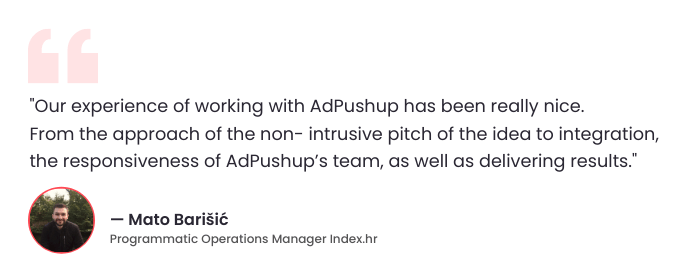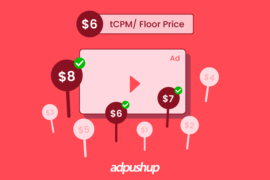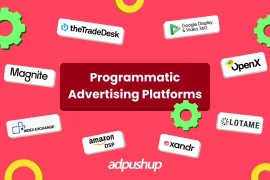Looking to maximize your programmatic video ad revenue? Check out these 10 tips on programmatic video advertising that can help you increase your earnings and improve your overall ad strategy.
Leaving the traditional methods of buying/selling video ad inventory behind, programmatic advertising has been making great strides ever since it has been introduced in the advertising realm.
It has revolutionized the way we buy and sell video ad space. As a result, publishers have been able to adopt new monetization strategies that were not possible with traditional methods. One such example is out-stream video advertising, which allows publishers to display video ads on non-video content.
Following the trend, Google enabled outstream video ads for its partnered publishers, opening multiple demand channels for video inventory.
Since then, publishers of different sizes have started experimenting with video advertising.
But when it comes to making a profit, many publishers lack a robust strategy. If you are looking for tips to increase video ad revenue, then we have the right ones for you.
Before we get into programmatic video advertising tips, let’s quickly understand what is it.
Also Read – Programmatic Video: What It Is, How It Works, Benefits, and Future
What is Programmatic Video Advertising?
Programmatic advertising refers to the media buying process, where brands or advertisers purchase the ad space online. There are multiple platforms out there, allowing advertisers and publishers to buy/sell media.
Now that you have got a fair idea of programmatic advertising, it goes without saying that programmatic video advertising is where publishers their ad space for video ads.
Why Publishers Should Consider Programmatic Video Advertising?
Programmatic advertising is all the rage nowadays, with over 244.4 million digital video viewers in the United States alone. Not to mention, internet users spend about 6 hours and 48 minutes per week on video content. These stats make it very evident why video marketing has been beneficial for both publishers and advertisers.

That being said, let’s now take a look at the best practices for programmatic video advertising.
Optimize for Placement
The placement of video ads plays a very important role when it comes to getting users’ attention. If a user can’t find the video ad, how would they see it? Hence, you need to optimally find a location and place a video ad unit.
For instance, the viewability of video ads above the fold is 73%, and below the fold is 45%. Above-fold video ads should bring on better viewability but that doesn’t mean below-the-fold placement should be ruled out.
Identify the average time spent by users on your webpage and the placements explored more by them. Next, you can also try moving the video player higher on your webpage and app to record any changes in the viewability rate.
Similarly, you should consider dynamic play viewports that autoplay videos only when an ad unit is active on the user’s viewport. This saves advertisers from wasting their money on non-viewable ads. This also reduces page load time by stopping webpages from rendering videos that are not seen by anyone.

Test Out Video Players
Large video players are easily noticed by users. For example, 2560 x 1440 player sizes get attention of 95% of users. Other large sizes like 667 x 375, 1024 x 768, and 1280 x 720 are noticed by 90% and more users.
Clearly, larger-sized video ad units are more viewable.
As a video player strategy experiment with click-to-play to improve CTR for video ads. Basically, if a user clicks on the video ad to see it, advertisers will get a clear signal of user interest. This, in return, should improve the value of your inventory making it easy for advertisers to further target the user.
Be careful if you are using autoplay ads. Better Ad Standards had made this clear that autoplay video ads with sound on is one of the most disruptive ad formats. Hence, it is advised to try muted video ads for the purpose of video ads that play in line with Chrome autoplay policy.
Autoplay Ads
No matter how engaging, relevant, and valuable a video ad you have in your advertisement, if users end up passing that video, it will be of no use. To decrease the likelihood of the users just passing through the video ads, implement autoplay ads.
As the name suggests itself, autoplay ads eliminate the need to manually play the video. Thus, as soon as the user comes across the video, it starts playing auto-playing.
However, as mentioned earlier, certain policies have been set forth by Google for using autoplay ads. Make sure you keep the videos muted. Users are the ones to decide whether or not they would like to unmute the video.
Also Read – Types of Video Ads, Best Practices & How Are They Served
Perform Periodic Video Ad Audits
Publishers are advised to be wary of poor user experience. This includes bad placements and unmet viewability standards. In such a case, publishers not only lose the users’ attention but also advertisers’ bids and hence, see a decrease in ad revenue.
It is recommended to schedule periodic audits to check the performance of the video inventory and make necessary fixes. Here are few things you need to consider:
- Look for latency issues: Video files are large in size and add to the page loading speed. 53% mobile users don’t wait for more than 3 seconds for a webpage to load and bounce to a different site. Best practices for video ads include lazy loading and placing video ads below the fold.
- Check prefetching opportunities: Prefetching allows webpages to start getting the details of video ads from the server before the ad starts to load on the user’s browser. This allows appropriate loading time to video ads considering these are large in size.
- Audit for VAST error: VAST error stops ad request and ads from playing on screen. If you use Google Ad Manager, then keep an eye on VAST performance for video ads. Fix the listed VAST errors and make it a periodic practice.
Get Started with Video Header Bidding
Try selling your video inventory via video header bidding. Video header bidding is a great method for publishers to increase demand on their inventory by adding demand outside Google.
Prebid, an open source header bidding wrapper, allows video ads (instream and outstream). For outstream videos, the implementation is easy—adding wrapper (Prebid.js) to the website head code. If you already have a wrapper added to your site, then enable ‘video’ media format and add video demand (like AppNexus).
Instream implementation is a bit complicated for header bidding. Hence, only a few video players allow header bidding options.
Video header bidding ensures greater demand and control over the inventory. If competed with Google Ad Exchange, this should result in more demand, bid pressure, and better profit for publishers.
Try the Video Ad Solution Offered by Google Ad Manager
Google Ad Manager supports three types of video ads: Linear Ads (Pre-roll, Mid-roll, and Post-roll), Non-linear Ads (Overlay, and Non-overlay), and Companion Ads.
The automation and reporting provided by Google is better than any other platform out there. Here are some featured by GAM video solution:
- Create video inventory
- Generate video ad tag
- Create video line item
- Generate video reports
The intelligent viewability feature for Google Ad Manager calculates the following viewability metrics:
- Active View: The overall viewability tracker
- Active View Measurable Impression: Number of times ads appeared in Active View
- Active View Viewable Impressions: Number of times ads considered as viewable
- Active View Measurable Rate: Ratio of viewable impressions by total impressions (viewable + non-viewable)
- Active View Viewable Rate: Ad viewability rate—the percentage of time the ads appeared on site and were viewable.
Since video advertising is different from display advertising, GAM asks publishers to integrate Interactive Media Ads (IMA) SDK. This is to use Google ad serving platform and to access Google Ad Exchange demand and dynamic ad insertion.
Join Multiple Ad Networks
One of the most common challenges publishers experience is achieving a high ad fill rate. To address this issue, you must establish relationships with multiple ad networks.
By doing this, publishers have a diverse range of ad options and increase the likelihood of having available ads to fill their inventory. This will ultimately lead to higher revenue and a more sustainable business model.
There are plenty of video ad networks available for publishers out there. So make sure you sign up on them and invite quality advertisers to your website.
Also Read – Guide To Create Video Ads That Convert – AdPushup
Focus on First-party Data Planning and Targeting
Data privacy laws are getting more strict. Make sure you use the user’s data responsibly.
The success of advertisers’ campaigns depends on user data offered by you. However, you need to have the user’s permission to use their data for targeting (as noted in GDPR, CCPA, and LGPD).
Coming back to the advertiser’s campaign, video ad creation takes more time and money. And in return, advertisers expect better user engagement from them. It puts pressure on publishers to keep up with targeting and user engagement while maintaining user privacy.
Only optimal use of first-party data can help publishers. Here is how you should plan it out:
- First-party data for publishers is user information collected by their websites. Before you start using it, make sure you have the user’s consent for the same.
- Consent includes permission to share users’ data, track their online behavior, show them ads, and many more. It is advisable to adhere to IAB’s advertising guidelines.
- It is recommended to get started with data management platforms and/or consent management platforms.
Doing this should avoid data leakage, and improve user experience and the effectiveness of ad campaigns.
Fallback Options
Let’s face it, no publishers want to have an empty ad inventory with no advertisements since a significant number of their revenue depends on it. Running out of advertisers is common for publishers. However, you can always decrease the likelihood of such situations by implementing fallback options.
What are fallback options? It’s a strategy that many publishers have put in the place to ensure their ad inventory is never empty. Fallback options are put in the work when your primary sources are unable to deliver an ad.
Watch Out for Video Advertising Trends
Data shows advertisers are willing to spend more on video advertising in the coming years. For publishers, video advertising is a hot market to make good money out of it.
When starting with video advertising make sure you have the following things in mind:
- The balance between display and video inventory: Both inventory types have their own pros and cons, hence while assigning inventory to display and video, make sure you understand the potential of each for your inventory.
- Track popular placements and size: Placements and sizes that get the most bids from advertisers are the popular ones. Putting these placements and sizes ensure the interest (bids) of more advertisers on your video inventory.
- Video ad viewability: Ad viewability metrics are volatile and keep on changing. Hence, it is recommended to track the industry trend to avoid showing intrusive ads to users.
- Optimize for desktop and mobile, separately: The screen and user intent for these devices are very different. For instance, vertical video ads are hit on mobile devices, however, might not work as well on desktop devices.
Final Words
With more demand and higher bid rates, video advertising is ruling over the display. Now is the best time for publishers to get started with video advertising and make higher revenue. Hope you found the aforement programmtaic video advertising tips helpful.
Are you a publisher who is also looking forward to maximizing yeild on your ad inventory. Look no further than us. At Adpushup, we leverage cutting-edge techologies and programmatic avdertising to help you fill your web inventory with the new video units. Click here to know more.
Frequently Asked Questions – Programmatic Video Advertising
Leaving the traditional methods of buying and selling ad space behind, Programmatic video advertising works by automating and improving the process. Not only does it automate the process, but helps finding the most relevant ad inventory at the best possible terms. Before hunting for the ad space, buyers need to have a predefined budget ad.
There are plenty of benefits of programmatic video ads. Here are some of them:
– Reduced cost
– Higher ROI
– Scalable & flexible spending
– Audience optimizing & targeting abilities
The list goes on. There is a lot more than that.
The four main components of programmatic are:
DSP (Demand Side Platform)
SSP (Supply Side Platform)
DMP (Data Management Platform)
Ad Exchange

Deepak has a keen eye for detail and a deep understanding of the ad tech landscape. Whether it’s through in-depth articles, thought-provoking insights, or compelling storytelling, he’s dedicated to helping people navigate the complex world of ad tech with the simplicity of his words.








